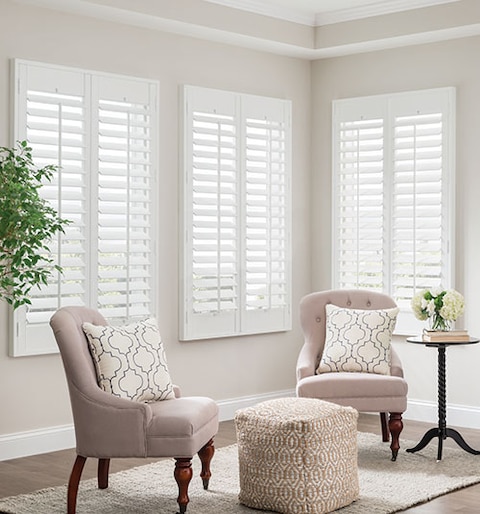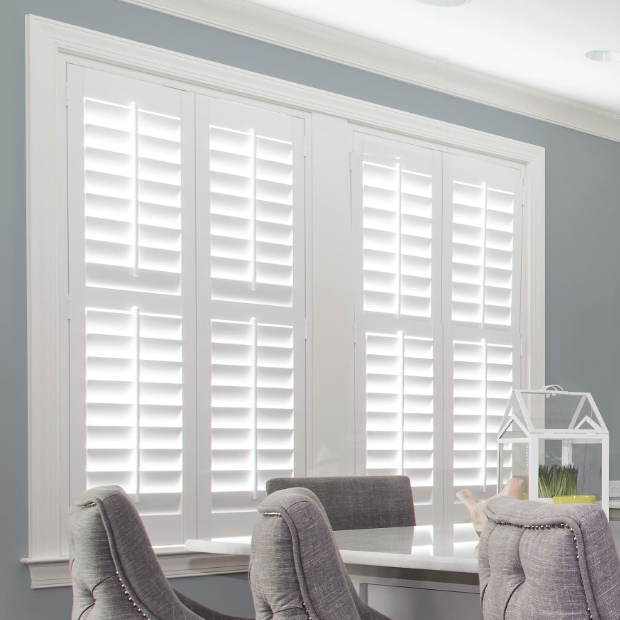What to Take into consideration When Picking Between Blinds and Shutters for Your Windows: A Detailed Evaluation of Each Choice's Advantages
Picking the right home window therapy is a decision that transcends simple visual appeals; it includes functionality, maintenance, and long-term investment. Blinds offer a flexible and cost-effective solution, while shutters supply unequaled longevity and design.
Key Differences In Between Blinds and Shutters
Regularly, home owners locate themselves deliberating in between shutters and blinds when selecting home window treatments. Recognizing the vital differences in between these two choices can substantially affect their decision-making procedure.
Blinds are commonly made from materials such as timber, synthetic wood, light weight aluminum, or plastic. They contain horizontal or vertical slats that can be changed to control light and privacy. The convenience of blinds permits a large range of sizes, shades, and styles, making them appropriate for different space looks. Blinds are typically extra cost-efficient, appealing to budget-conscious property owners.
In comparison, shutters are strong home window treatments that can be custom-fitted to the home window framework. They are frequently built from durable materials like wood or composite, offering a much more permanent and robust option. Shutters offer far better insulation and can improve the overall power efficiency of a home. In addition, they often call for even more maintenance and investment contrasted to blinds because of their building and installation complexity.

Advantages of Blinds
Blinds use a versatile and functional remedy for home owners seeking reliable home window treatments. One of the primary advantages of blinds is their versatility to numerous styles and choices. Available in various materials such as wood, artificial wood, light weight aluminum, and fabric, they can complement any type of interior decoration scheme. Additionally, their variety of colors and structures enables personalization to match existing decor.
An additional substantial advantage of blinds is their ease of operation. Lots of contemporary blinds come with easy to use devices, including cordless alternatives and motorized systems, making them available for any ages. This comfort is improved by their ability to give accurate light control, permitting homeowners to easily readjust the degree of sunshine getting in an area.
Blinds likewise provide excellent privacy alternatives, as they can be totally opened, partly slanted, or entirely closed, depending on the preferred degree of seclusion. Additionally, they are generally more cost-effective than shutters, providing an affordable remedy without sacrificing style or performance. Upkeep is simple, as many blinds can be cleansed with an easy wipe-down, ensuring that they stay an appealing attribute in any home for years to come.
Advantages of Shutters
Shutters provide an unique collection of benefits that make them an enticing option for homeowners looking for long lasting and stylish window therapies. Among the primary advantages of shutters is their remarkable resilience - motorized blinds phoenix. Created from robust products such as wood, vinyl, or composite, they are made to stand up to the test of time and resist damages from UV rays, moisture, and temperature fluctuations

Shutters also use improved privacy and light control. Homeowners can quickly change the slats to achieve the preferred level of brightness while keeping personal privacy from the outside. Unlike blinds, which may flex or droop in time, shutters keep their shape and performance.
Moreover, shutters can increase the value of a residential property (motorized blinds phoenix). Their classic aesthetic and toughness attract prospective customers, making them a worthwhile financial investment. In recap, the sturdiness, power performance, privacy control, and possibility for boosted home worth make shutters an engaging option for window treatments
Aesthetic Considerations
When selecting window therapies, aesthetic factors to consider play a critical duty in improving the total style and ambiance of a space. Both blinds and shutters offer distinctive aesthetic attributes that can match various interior designs, from modern-day to traditional.
Blinds usually supply a smooth, minimal appearance, conveniently available in a series of shades and materials. This adaptability allows property owners to coordinate blinds with existing style, developing a unified appearance. Their vertical or straight slats can include a contemporary edge, making them ideal for city setups.
In comparison, shutters exhibit a traditional sophistication that improves traditional and rustic interiors. Their strong framework and personalized coatings, such as timber spots or painted choices, evoke a sense of eternity. Shutters can serve as a declaration item, accentuating the window while using a high end aesthetic.
Ultimately, the selection in between shutters and blinds ought to reflect not just individual design yet likewise the preferred environment of the area. By very carefully thinking about exactly how each choice aligns with the total design vision, home owners can successfully improve their room's aesthetic appeal, ensuring an unified and welcoming setting.
Cost and Upkeep Factors
Cost and upkeep are important aspects to consider when choosing between blinds and shutters for click for source window treatments. Blinds are normally more affordable, with a large variety of choices offered at different rate factors.
In contrast, shutters often tend to carry a greater first price because of their custom manufacturing and robust building. This financial investment may yield long-term savings, as shutters are commonly much more sturdy and require much less frequent replacement. They likewise provide superior insulation, potentially reducing energy costs in time.
Upkeep plays a considerable role in the general expense of home window therapies. Blinds usually need regular dusting and periodic washing, while shutters can be wiped down with a moist cloth for cleansing, making them simpler to maintain. In addition, shutters are much less at risk to harm from UV rays and moisture, adding to their long life. Inevitably, the selection in between shutters and blinds must stabilize both initial financial investment and recurring upkeep needs to ensure an acceptable roi.
Conclusion

Blinds present a cost-effective and adaptable option, while shutters use unmatched toughness and style.Cost and maintenance are essential facets to consider when selecting in between blinds and shutters for home window treatments. Blinds normally need routine dusting and occasional washing, while shutters click this can be cleaned down with a wet towel for cleaning, making them less complicated to keep. Ultimately, the selection in between blinds and shutters ought to balance both preliminary investment and ongoing maintenance needs to make sure an adequate return on investment.
In summary, the choice between blinds and shutters hinges on different factors, including material make-up, style flexibility, and price.